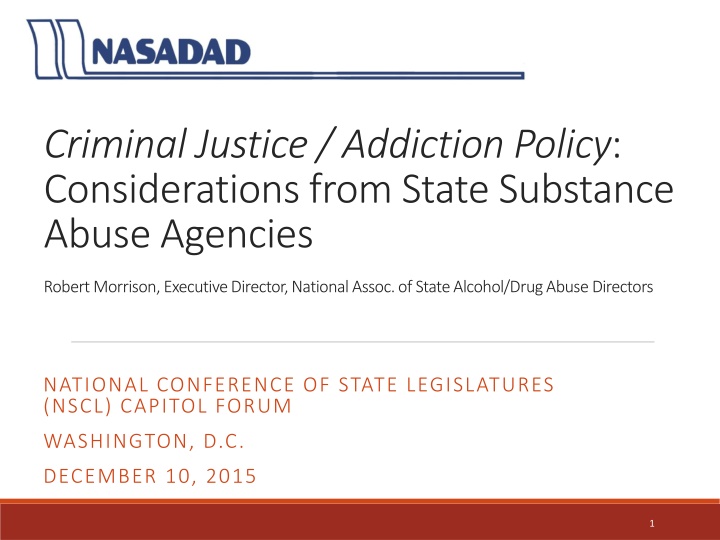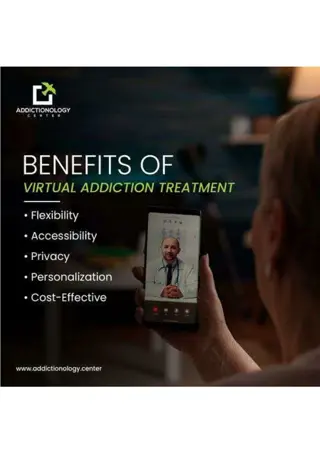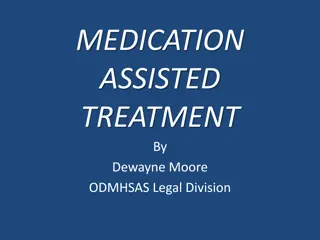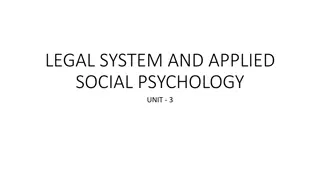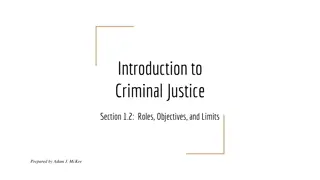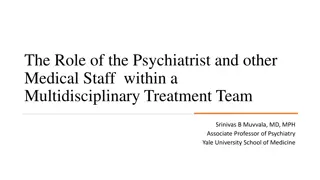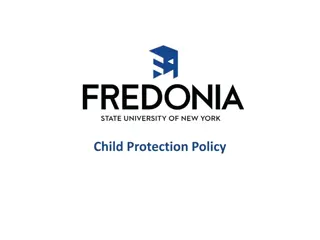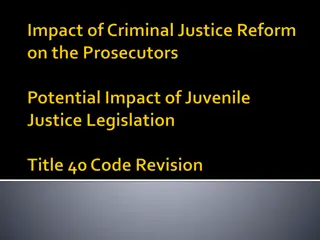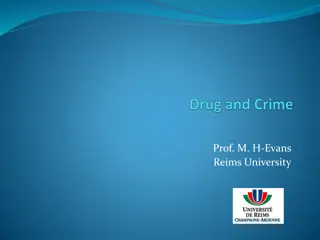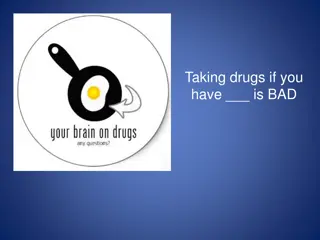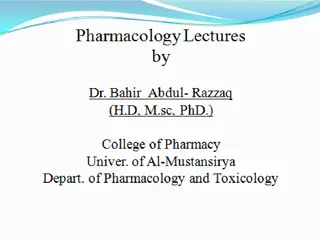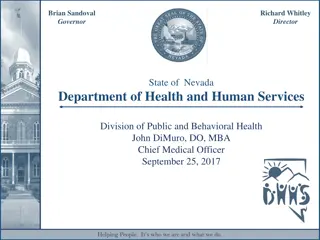State Substance Abuse Agencies' Role in Criminal Justice and Addiction Policy
Consider insights by Robert Morrison, Executive Director of the National Association of State Alcohol/Drug Abuse Directors, on the role of state substance abuse agencies in addressing addiction within the criminal justice system. Topics cover NASADAD's background, state initiatives, and ways agencies can support CJ entities, including referrals to treatment and trends in law enforcement. Explore examples like the Gloucester, MA Police Dept.'s Angel Program.
Download Presentation

Please find below an Image/Link to download the presentation.
The content on the website is provided AS IS for your information and personal use only. It may not be sold, licensed, or shared on other websites without obtaining consent from the author.If you encounter any issues during the download, it is possible that the publisher has removed the file from their server.
You are allowed to download the files provided on this website for personal or commercial use, subject to the condition that they are used lawfully. All files are the property of their respective owners.
The content on the website is provided AS IS for your information and personal use only. It may not be sold, licensed, or shared on other websites without obtaining consent from the author.
E N D
Presentation Transcript
Criminal Justice / Addiction Policy: Considerations from State Substance Abuse Agencies Robert Morrison, Executive Director, National Assoc. of State Alcohol/Drug Abuse Directors NATIONAL CONFERENCE OF STATE LEGISLATURES (NSCL) CAPITOL FORUM WASHINGTON, D.C. DECEMBER 10, 2015 1
Topics to Cover Background on NASADAD Role of State substance abuse agencies Emerging themes/impact of opioid crisis Examples of State initiatives Considerations 2
Role of State Substance Abuse Agencies Placement in State gov t varies by State Develop Annual Statewide plans for services for safety net populations Ensure service quality; accountability; service improvement; service coordination 3
How can State Substance Abuse Agencies Help CJ Entities? Link to the treatment provider / recovery community Assist with navigating prevention/treatment system Knowledge of clinically appropriate care assist with trainings NASADAD members partner w/DOC s, SAA s, Drug Courts, Reentry Programs, Counties, etc. 4
CJ Referrals to Treatment On average, 40 percent of people in publicly funded treatment programs are referred by the criminal justice system but percentages vary depending on the State In 10 States, between 51 percent and 60 percent of referrals come from CJ system In 3 States, between 61 percent and 70 percent of referrals come from CJ system 5
Trends Law enforcement & opioid issues Medication Assisted Treatment (MAT) Drug/Family/Veterans Courts 6
Gloucester, MA Police Dept. Angel Program Policy Chief Campanello leads effort to respond to overdose If people struggling with addiction go to P.D. Anyone who enters seeking help unless they had outstanding warrants will not face charges or arrest Officer takes them to local hospital and they are paired with a volunteer to navigate system Agreements with local treatment centers Effort to address waiting time for service 7
Gloucester, MA Police Dept. Angel Program Campanello learned of high cost of naloxone at local pharmacy; told pharmacy about the police department s new program, and it lowered the cost to $20 per pack Police department is now able to provide naloxone kits to individuals with SUDs for free Over 100 individuals have sought help at the police station 8
Police Assisted Addiction and Recovery Initiative (PAARI) Gloucester initiative leads to creation of PAARI 501 C 3 designed to help other departments initiate similar programs Cooperstown, New York latest to launch similar program in November 2015 working with PAARI http://paariusa.org/ 9
Law Enforcement/Naloxone Law Enforcement/Naloxone States With Law Enforcement Units Carrying Naloxone: CA, CO, CT, DE, GA, FL, IL, IN, KY, ME, MD, MA, MI, MN, N.H., N.J., N.M., NY, N.C., OK, OH, OR, PA, R.I., TN, VT, VA, WA, WV, WI (N.C. HRC, 2015) Programs vary in scope, size Issues to consider: Training, storage, funds for naloxone, linkage overdose victim to further services 10
Law Enforcement/Naloxone: Resources Law Enforcement Naloxone Took Kit: http://store.samhsa.gov/shin/content/SMA14- 4742/Overdose_Toolkit.pdf SAMHSA Overdose Tool Kit: http://store.samhsa.gov/shin/content/SMA14- 4742/Overdose_Toolkit.pdf 11
Warm Hand Warm Hand- -Off to Services Off to Services Rhode Island s Anchor Ed Program July 2014 Certified recovery coaches on call in emergency hospital rooms from 8pm Friday nights to 8am Monday morning Kent Hospital was first to participate expanded to others Goal: Promote a connection to some level of services after the overdose 12
Warm Hand Warm Hand- -Off to Services Off to Services Data from Anchor Ed Program Seven months into the program, 112 survivors of overdose were seen in hospital emergency rooms 88 percent engage in recovery support 38 percent had at least 1 prior overdose Approximately half revived by naloxone 13
Drug Courts Drug courts identified by NASADAD members as a top priority within DOJ Portfolio Members encourage connection between local Drug Courts and State substance abuse agency State substance abuse agency helps with: Planning Data sharing Capacity Standards of care 14
Ohios Specialized Dockets Payroll Subsidized Payroll Project Enhanced support for Drug Courts, Family Courts, Veterans Courts by ODMHAS (Tracy Plouck, Director) $4.4 million in SFY 2015 Family Dependency Courts: Specialized dockets focused on addicted parents charged with abuse/neglect/dependency of minor children Reduce kids removed from home Increase kids staying at home with parents under CPS supervision Substance use disorder services for family 15
New Yorks Initiative (State Agency: Arlene Gonzalez Sanchez, OASAS) 146 Drug courts in operation as of 2014 90 criminal court 35 family court 15 juveniles Rest - local 85,000 participants Senate Task Force on Heroin and Opioid Abuse held listening sessions around the State 16
New Yorks Initiative S4239B/A6255B signed into law by Governor Cuomo in October 2015 Prohibits courts to require defendants to stop taking medications for the treatment of substance use disorders Methadone Buprenorphine Long acting depot naltrexone Similar legislation signed by Gov. Christie in N.J. 17
Missouri, CJ and MAT State Substance Abuse Agency Dir: Mark Stringer In 2008, the Missouri Division of Behavioral Health (DBH; SSA) worked with the Department of Corrections (DOC) to provide funding to support the purchase of medications for clients in the criminal justice system who were seeking treatment DBH collaborated with DOC to implement a pilot project involving medication-assisted treatment (MAT) for the re-entry population SSA has worked closely with the Office of State Courts Administrators (OSCA) and with individual judges A St. Louis drug court judge who was an early adopter of MAT was concerned that offenders were relapsing or overdosing before they could come before his drug court He worked with the DBH to pioneer the use of injectable naltrexone in the St. Louis jail Depot naltrexone blocks opiate receptors in the brain, eliminating the euphoric effects and preventing cravings Administered in the form of a shot once per month 18
Missouri, CJ and MAT State Substance Abuse Agency Dir: Mark Stringer Upon release, volunteers received medication and substance abuse counseling through DMH contracted community agencies in St. Louis These individuals are less likely to relapse, reducing the likelihood of re-arrest and re-incarceration Drug courts include medications as a reimbursable service, and all drug courts are encouraged to use MAT DBH reviewed the Request for Proposal (RFP) that is distributed to drug court contracts and suggested language on MAT that that was accepted Providers are asked to indicate whether MAT is provided; if it is not provided, they are asked how and with whom MAT services are arranged and how all services are coordinated 19
Considerations Concerns/Lost Opportunities Dwindling federal funds for in-prison substance abuse services reductions to DOJ s Residential Substance Abuse Treatment Program Elimination (close to) of the Enforcing Underage Drinking Laws (EUDL) Program Previously allotted $360,000 to each state for enforcement Cuts by Congress allow now for only a resource center Previously -- helped establish/strengthen partnerships between law enforcement and public health 20
Considerations Promote criminal justice initiatives that involve the State substance abuse agency Example in CARA S. 524/H.R. 953 Section 501 Authorizes jointly administered grant to State criminal justice agency and State substance abuse agency Grant funds used to facilitate of enhance collaboration around addiction/criminal justice planning. Service delivery, data strategies, reentry approaches 21
Considerations Promote opioid initiatives that encourage linkages to service side Example in CARA S. 524/H.R. 953 Section 202 Law enforcement Naloxone Training/Implementation Requires application to describe collaboration between State substance abuse agency and enforcement agency Includes identification of protocols that help service linkage May be information sharing on treatment/recovery 22
Thank you Robert Morrison NASADAD 202 293 0090 rmorrison@nasadad.org http://www.nasadad.org 23
